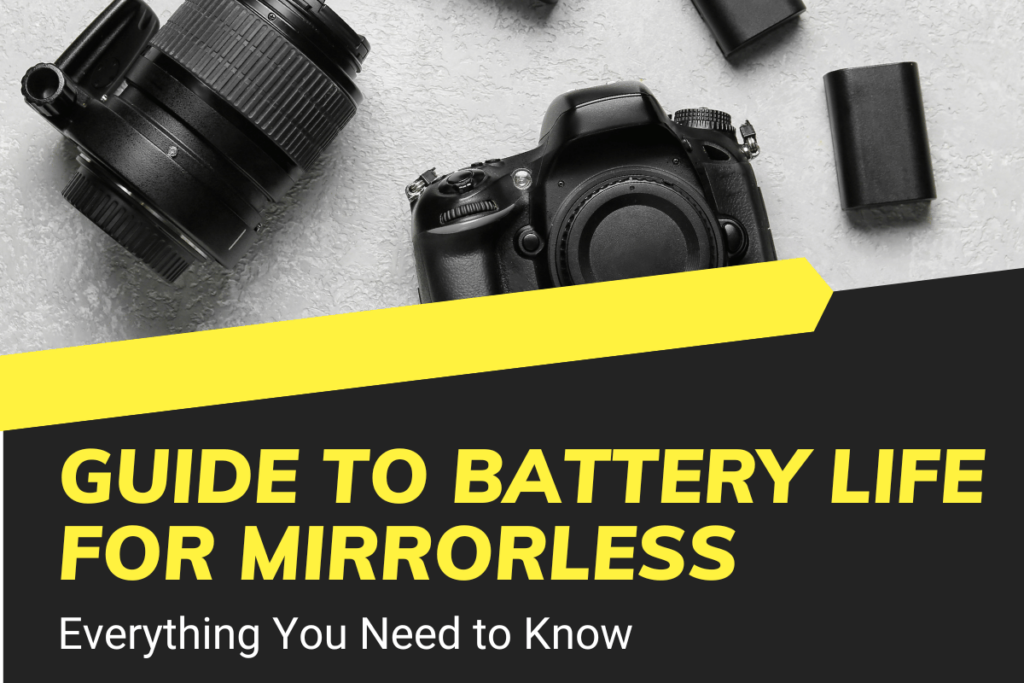
Mirrorless cameras are the sleek, new kids on the block. They ditch the traditional mirror mechanism of DSLRs. This creates a lighter and more compact design. They offer many perks, however, they’re also notorious for one thing: battery life.
We’ll explore not just how long mirrorless camera batteries last. We’ll also compare them across various brands and models. We will also do a comparison of different brands and models of batteries. This will help you make an informed decision for your photography adventures.
How Long Do Mirrorless Camera Batteries Last?
Average Battery Performance
CIPA, the Camera & Imaging Products Association, gives us a roadmap for average battery life with their ratings.
CIPA’s numbers show the average mirrorless camera battery offers about 300-400 shots per charge. However, don’t take this as gospel. Your mileage may vary based on real-world conditions. It also depends on how you handle your equipment.
Real-World Battery Life
Sure, CIPA ratings are handy. But nothing compares to testing in the trenches of photography.
If you find your camera flashing the dreaded low battery signal sooner than expected, remember that factors like using the electronic viewfinder, frequent reviewing of shots on the rear LCD, or chilling in a cold snap can make a significant dent in your battery life.
Factors affecting mirrorless camera battery life
Autofocus and Image Stabilization
Ah, autofocus (AF) is the gift to photographers everywhere. Until you realize it’s quietly sipping on that precious battery of yours. Continuous AF and in-body image stabilization work hard. They keep your shots steady and in focus. These features can be power-hungry, often responsible for a significant power draw.
Shooting Modes and Settings
Let’s talk about shooting modes and settings. They can munch through your battery like it’s a packet of snacks on movie night. Burst mode? Flash? HDR? Video mode? They might as well have a direct line to your battery’s life force. And don’t get us started on the infamous ISO. And the white balance adjustments and resolution settings are also a pain!
But you, my friend, can outsmart them. Settle for the optimal resolution and frame rate that you need. Don’t go for what sounds fancy. This will save loads of power. Natural light isn’t just for influencers. It’s your ally in conserving battery life. Make friends with it. Sometimes, letting your camera’s auto settings take the wheel isn’t a bad idea. It can be more power-efficient and let you focus on the shot, not the settings.
Comparison of mirrorless camera batteries with Dlsr and Point-and-Shoot camera batteries
DSLR vs. Mirrorless: A Power Struggle
When compared to DSLRs, your mirrorless camera may seem to have weaker battery performance. DSLRs are known for their longevity. They often provide around 750 to 1,100 shots per charge. This clearly outpaces the 300-400 shots from an average mirrorless model.
The mirrorless camera’s secret lies in its constant use of the electronic viewfinder and LCD screen. They are real power sippers. This doesn’t mean you should write off mirrorless cameras just yet. They’re lighter and more compact, making them a gem when you want to shoot on the go without the heft.
Size Matters: Point-and-Shoot and Smartphones
Point-and-shoot cameras and smartphones tend to have even shorter battery lives than mirrorless cameras. They are handy, but their battery lives are even shorter. These devices are usually not engineered for longevity like dedicated cameras are. They’re built for convenience. However, your smartphone practically lives in your hand. The camera’s essentially an app—ready for a quick draw photo.
Plus, point-and-shoot batteries win on cost and availability. You can grab them at any convenience store in a pinch.
Weighting Out the Benefits
Mirrorless camera batteries might be smaller and lighter but performance takes a hit. In travel scenarios where every ounce in your backpack counts, this could be a blessing. For wildlife or sports photographers, though, the reduced weight might not translate to enough power for all-day shoots.
Comparison of battery life of mirrorless cameras of different brands and popular models.
Sony vs. Fujifilm
Sony stands out for its mirrorless camera battery life. Models like the Alpha a6100 boast up to 420 shots per charge. Meanwhile, Fujifilm makes a decent competitor. Take the X-E4, for example; it offers around 350 shots. But here’s the kicker: Sony integrates Z-series batteries in newer models for longer life. Fujifilm relies on its retro charm and consistent performance.
Canon’s Leap and Nikon’s Charge
Canon doesn’t lag. The EOS R10 positions itself as a strong contender by delivering a solid 430 shots per charge. On the flip side, Nikon’s Z50 dashes in with around 320 shots. But you’ve gotta appreciate Nikon’s savvy. They share DSLR batteries with their mirrorless line. If you’re switching over, you won’t need new spares.
Olympus and Panasonic: The Underdogs
Don’t overlook Olympus and Panasonic, though. Despite being less talked about, Olympus mirrors larger brands’ stamina. Many models enjoy up to 360 shots per charge. In contrast, Panasonic excels in video performance. It does make some sacrifices in stills quality.
Sony Alpha a7 III
When you’re out on a shoot, the last thing you want is to run out of juice. That’s where the Sony Alpha a7 III steps in, offering a CIPA rating of 610 shots per charge. But let’s get real – if you’re shooting with the EVF, expect that number to drop a bit. Real-world users report squeezing out around 710 shots. They can do this thanks to its hefty 2280 mAh battery. The a7 III is like that friend who doesn’t bail on you – dependable, with stamina to spare.
Fujifilm X-T3
Let’s chat about the Fujifilm X-T3. It’s the extrovert of cameras – loves being out and about but tends to run out of steam quicker. With a CIPA rating of 390 shots, it’ll get you through most of your day’s adventure. But remember, with great picture quality comes greater power consumption. The 1260 mAh battery is not the largest out there. Yet, for what it lacks in capacity, it makes up in charm and image quality.
Canon EOS R
The Canon EOS R is sort of the new kid on the block. It’s eager to impress with a CIPA rating of 370 shots. It may not lead the pack, but users have noted a real-world output that exceeds the official spec. This is especially true if you’re wise with your settings. Sporting a 1875 mAh battery, it might be wise to keep a spare in your bag – because who likes to pause the fun for a recharge?
Nikon Z6
Ah, the Nikon Z6 – a true workhorse. With a CIPA rating of 310 shots, some might underestimate this beast. But in the hands of a power-conscious shooter, the Z6 can surprise you. Its 2050 mAh battery doesn’t mess around. It’s the kind of camera that encourages you to keep shooting. You can capture those moments without worrying about the battery constantly draining.
Tips to extend mirrorless camera battery life
Battery grip and extended battery pack
These accessories can breathe new life into your mirrorless camera. They provide extra juice. For example, the Canon BG-E21 doubles the battery life of its EOS 6D Mark II model. Meanwhile, the Sony VG-C3EM is a perfect match for the A9 and A7 series. They add weight to your camera rig. However, you can shoot longer, which is essential for day-long photo sessions.
Lower Display Brightness and Turn Off Viewfinder Auto-Switch
Let’s tone things down a bit—your camera’s display brightness, that is. Lowering this setting can be a lifesaver for your mirrorless camera battery life. This simple tweak alongside turning off the viewfinder auto-switch feature can work wonders. If you’re squinting at your display on a sunny day, fear not. You’ll likely still manage just fine with a slightly dimmer screen.
You might miss the sun-like glow of your display, but your battery will thank you. Just delve into the camera’s menu, typically found under the display or viewfinder settings, and bask in the newfound longevity of your shoots.
Optimize Autofocus and Image Stabilization Settings
Stay sharp—both in your photos and battery management. Optimizing your camera’s autofocus and image stabilization settings can cut down the power drain. Is your subject still as a statue? Maybe it’s time to switch off that image stabilization. Settling on the right autofocus mode for the task at hand means your gear won’t overwork. This saves battery.
Use Power-Saving Shooting Modes
Every drop of power counts, and your camera’s power-saving modes are the unsung heroes. ‘Eco’ and ‘sleep’ modes might scale back some functions. However, they’ll keep your camera alive for crucial moments. ‘Airplane mode’ may disable some flashier camera features. However, it can also extend your shooting sessions.
Limit Use of Wi-Fi and Other Connectivity Features
Our world is always connected. It’s hard to imagine turning off anything that keeps us plugged in. If you want to save battery life on your mirrorless camera, you must rein in the Wi-Fi and Bluetooth features. Disabling remote control and geotagging functions isn’t just good for battery life. It’s also great for keeping a low digital profile.
Turn Off Unnecessary Features and Settings
Think of your camera as a smartphone for a sec. All those extra features and settings? They’re power hungry. Turning off the ones you don’t need, like touch screen controls or sound alerts, can make your battery last much longer. Perhaps you’ll miss some of the flash, but your camera will last longer. You can focus on your shots, not battery bars.
Carry Spare Batteries and Portable Chargers
Lastly, it never hurts to be over-prepared. Carrying spare batteries and portable chargers means you’re ready for any power slump. Photography aficionados swear by keeping an arsenal of backups. It might mean a little extra weight in your bag. But when you’re able to capture the sunset after everyone else has packed up, you’ll know it was worth it.
Conclusion
Mirrorless cameras may have shorter battery lives compared to DSLRs. But, their compactness and quality make them a worthy choice for photographers. You can significantly extend your shooting time. Understand the factors that affect battery life. Use strategies like using battery grips, optimizing settings, and carrying spares. Then, you can fully embrace the advantages of mirrorless photography.
Frequently Asked Questions
What are some tips to extend the battery life of mirrorless cameras?
To extend the battery life, turn off your camera when it’s not in use, reduce the LCD screen brightness, minimize the use of continuous autofocus, and consider using a power-saving mode if available. Carrying spare batteries is also advisable.
How does the Sony Alpha a7 III compare to other mirrorless cameras in terms of battery life?
The Sony Alpha a7 III has a CIPA rating of 610 shots per charge, which is higher than the Fujifilm X-T3, Canon EOS R, and Nikon Z6, making it a strong competitor in terms of battery life among popular mirrorless cameras.
What is the CIPA rating for the Fujifilm X-T3?
The Fujifilm X-T3 has a CIPA battery life rating of 390 shots per charge.
How many shots can the Canon EOS R take on a single charge?
The Canon EOS R can take approximately 370 shots per charge according to its CIPA rating.
What is the battery life of the Nikon Z6 as per its CIPA rating?
The Nikon Z6 is rated at 310 shots per charge by the CIPA standards.

